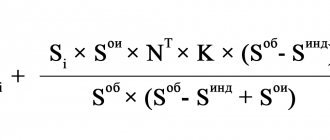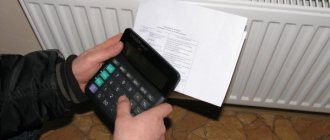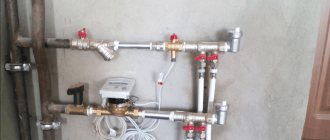In Ukraine, the unit of measurement of thermal energy is calculated in Gcal (gigacalories).
When the reporting month comes to an end, in order to transfer the heat meter readings to the heat supply organization, it is often necessary to convert the readings into gigacalories. Due to the fact that many do not know how to calculate correctly, we will give an example of how to do this: There are such quantities:
— Gcal (gigacalories Gcal), — GJ (gigajoules GJ), — MWh (megawatt hours MW*h), — KWh (kilowatt hours kW*h).
Why is this necessary?
Apartment buildings
It's very simple: gigacalories are used in calculations for heat. Knowing how much thermal energy is left in the building, the consumer can be given a very specific bill. For comparison, when central heating operates without a meter, the bill is issued based on the area of the heated room.
The presence of a heat meter implies horizontal sequential or collector distribution of heating pipes. outlets for supply and return risers have been installed in the apartment; the configuration of the indoor system is determined by the owner. This scheme is typical for new buildings and, among other things, allows you to flexibly regulate heat consumption, choosing between comfort and savings.
Horizontal collector distribution in the apartment.
How is the adjustment carried out?
- Throttling of the heating devices themselves. The throttle allows you to limit the flow of the radiator, reducing its temperature and, accordingly, heat consumption.
- By installing a common thermostat on the return pipe. The coolant flow will be determined by the temperature in the room: when the air is cooled, it will increase, when heated, it will decrease.
Private houses
The cottage owner is primarily interested in the price of a gigacalorie of heat obtained from various sources. We will allow ourselves to give approximate values for the Novosibirsk region for tariffs and prices in 2013.
Cost of a gigacalorie, taking into account transport costs and efficiency of the heating installation, rubles
How to correctly convert Gcal to kW and vice versa
It must be said right away that for a modern person the issue of converting values does not pose a particular problem, since you can easily and simply use online counters, which, as a separate option, are included on many websites with a thematic focus. However, each consumer should still learn to make calculations independently, as this allows them to accurately control their accounting and consumption of thermal energy in a house or other facility. Moreover, there is no need to go into the mathematical jungle, although it is quite acceptable: for accurate calculations, special formulas are provided that take into account all the factors affecting heat consumption. But this relates more to the design of heating systems, and in order to correctly calculate the amount that needs to be allocated to pay for utilities, it is enough to know only a few numerical values and coefficients.
First you should know that 1 Gcal is 1162.2 kW
, accordingly,
1 kW will be equal to 0.00086 Gcal/h
. Thus, if the heat meter shows consumption in kW, then finding out the number of Gcal received is quite simple - you just need to multiply the received data by a factor of 0.00086. For example, if heat consumption for the month was 300 kW, then you will need to pay for 0.258 Gcal.
If it is necessary to convert gigacalories to kW, then the first value should, accordingly, be multiplied by 1162.2. For example, if 0.400 Gcal is received, then this value will be equal to 464.88 kW.
Thus, if metering devices are installed in a house or apartment, the values of which do not coincide with those used in calculations for heat, then knowing only two constant values makes it easy to cope with filling out a payment document and paying for the consumed resource.
If a communal heat meter
, then there is no such problem, since the necessary calculations are carried out by the management company, which makes accruals in accordance with the data received and distributes them among the owners of the premises in proportion to their area. In this case, payment is made not only for the heat supplied to each individual apartment, but also for common areas: corridors, staircases and various utility rooms. To be fair, it should be noted that owners of individual metering devices must also pay for heating of common areas.
Therefore, regardless of the units in which the amount of heat supplied to the house is measured, payment is made for all thermal energy, that is, for each gigacalorie. In private homes and facilities with individual heating systems, a different method of accounting and payment for the heat received may be used and, most often, the unit of measurement is the amount of fuel consumed.
Counters
What specific data is needed for heat accounting?
It's easy to figure out:
- The flow rate of coolant passing through heating devices.
- Its temperature at the outlet and inlet of the corresponding section of the circuit.
Two types of meters are used to measure flow.
Meters with impeller
Meters intended for heating and hot water supply differ from those used for cold water only in the material of the impeller: it is more resistant to high temperatures.
The mechanism itself is the same:
- The coolant flow causes the impeller to rotate.
- It transmits rotation to the accounting mechanism without strong cooperation, using a permanent magnet.
Despite the simplicity of the design, the meters have a low response threshold and are well protected from data tampering: every attempt to slow down the impeller with an external magnetic field will be blocked by the presence of an antimagnetic screen in the mechanism.
Meters with differential recorder
The device of the second type of meters is based on Bernoulli's law, which says that the static pressure in a flow of liquid or gas is inversely proportional to its speed.
How to use this feature of hydrodynamics to calculate coolant flow? It is enough to block his path with a retaining washer. The pressure drop across the washer will be directly proportional to the flow rate through it. By recording pressure with a pair of sensors, it is easy to calculate flow rate in real time.
It’s curious: the design of the meter implies the presence of electronics in it. Most models of meters of this type provide not only raw data - water consumption and its temperature - but also calculate the actual use of heat. The control module of such devices has a port for connecting to a computer and can be reconfigured with your own hands to suit the changed calculation scheme.
But what if we are not talking about a closed heating circuit, but about an open system with the possibility of selecting hot water? How to record warm water consumption?
The solution is obvious: in this case, pressure sensors and retaining washers are placed on both the supply and return heating pipelines. The difference in coolant flow between the threads will indicate the amount of warm water that was used for household needs.
Why is this necessary?
Everything is very simple: gigacalories are used in calculations for heat. Knowing how much thermal energy is left in the building, it is possible to issue a fully specific bill to the consumer. For comparison, when central heating operates without a meter, the bill is issued based on the area of the heated room.
The presence of a heat meter implies horizontal sequential or collector distribution of heating pipes: outlets of supply and return risers are installed in the apartment; the configuration of the intra-apartment system is determined by the owner. This scheme is typical for new buildings and, among other things, allows you to flexibly regulate heat consumption, choosing between savings and comfort.
How is the adjustment carried out?
- Throttling of the heating devices themselves. The throttle allows you to reduce the flow rate of the radiator, reducing its temperature and heat consumption.
- By installing a non-specialized thermostat on the return pipeline. The coolant flow will be determined by the temperature in the room: when the air is cooled, it will increase, when heated, it will decrease.
The owner of a cottage is interested, first of all, in the price of a gigacalorie of heat taken from various sources. We will allow ourselves to give approximate values for the Novosibirsk region for tariffs and prices in 2013.
| Heat source | Price per gigacalorie taking into account transport costs and efficiency of the heating installation, rubles |
| Gas | 501 |
| Coal | 520 |
| Pellets (granulated sawdust) | 1754 |
| Electricity | 4230 |
| Liquefied gas | 3225 |
| DT | 3268 |
For comparison: central heating at the time of collecting statistical data cost 1,467 rubles per gigacalorie.
Alternative options
Just as there are various ways to provide housing with heat by choosing a coolant - water or steam, there are also alternative methods for calculating the heat received. Here are two more formulas:
Thus, you can do the calculations yourself, but it is important to coordinate your actions with the calculations of the heat supply organizations. Their calculation instructions may be completely different from yours.
The calculations will be much more complicated if you plan to install heated floors in the house, but here you will need to turn on electricity. And this is a completely different “opera”, with new performers, but from the same government agencies
Helpful advice. Often reference books provide information not in the national system of units of measurement, to which calories belong, but in the international system “C”. Therefore, we advise you to remember the coefficient for converting kilocalories to kilowatts. It is equal to 850. In other words, 1 kilowatt is equal to 850 kilocalories. From here it is not difficult to convert gigacalories, given that 1 gigacalorie is a million calories.
The calculation is even more necessary when it comes to heating a country house.
All meters, and not only the simplest brownie meters, unfortunately suffer from some measurement error. This is a normal situation, unless, of course, the error exceeds all conceivable limits. To calculate the error (relative, in percent), a special formula is also used:
- V1 and V2 are the previously discussed coolant flow rates, and
- 100 – conversion factor to percentage.
The percentage of error when calculating heat is considered acceptable - no more than 2 percent, given that the error of measuring instruments is no more than 1 percent. You can, of course, make do with the old proven method; here you don’t need to do any special calculations.
This solution is sometimes life-saving and the most convenient.
Conversion table
A quick translation of round numbers can be done using tables:
| Gcal to kW | ||||||||
| gigacalories/hour | 1 | 2 | 3 | 4 | 5 | 10 | 15 | 20 |
| kW | 1163 | 2326 | 3489 | 4652 | 5815 | 11630 | 17445 | 23260 |
| kW to Gcal | |||||||
| kW | 1000 | 5000 | 10000 | 30000 | 50000 | 100000 | 500000 |
| gcal/h | 0.85984 | 4.29922 | 8.5984 | 25.795 | 42.992 | 85.984 | 429.9226 |
When you need to dot all the i’s
But a completely reasonable question arises. “How can you count something that is invisible and capable of disappearing instantly, literally out the window?” There is no need to despair of this struggle with the air; it turns out that there are quite clear mathematical calculations of the calories received for heating.
Moreover, all these calculations are hidden in official documents of state utility organizations. As usual in these institutions, there are several such documents, but the main one is the so-called “Rules for accounting of thermal energy and coolant”. It is he who will help solve the question - how to calculate Gcal for heating.
The actual problem can be solved quite simply and no calculations will be needed if you have a meter not just for water, but for hot water. The readings of such a meter are already “filled” with data on the heat received. When taking readings, you multiply it by the cost tariff and get the result.
Basic formula
The situation becomes more complicated if you do not have such a counter. Then you will have to be guided by the following formula:
- Q is the amount of thermal energy;
- V – volume of hot water consumption in cubic meters or tons;
- T1 - hot water temperature in degrees Celsius. More precisely, use temperature in the formula, but reduced to the corresponding pressure, the so-called “enthalgy”. But in the absence of a better, appropriate sensor, we simply use the temperature, which is close to enthalgy. Professional heat metering units are capable of calculating enthalgy. Often this temperature is not available for measurement, so they are guided by the constant “from the Housing Office”, which can be different, but is usually 60-65 degrees;
- T2 is the cold water temperature in degrees Celsius. This temperature is taken from the cold water pipe of the heating system. Consumers, as a rule, do not have access to this pipeline, so it is customary to take constant recommended values depending on the heating season. in season - 5 degrees; off-season – 15;
- The “1000” coefficient allows you to get rid of 10-digit numbers and get data in gigacalories (not just calories).
As follows from the formula, it is more convenient to use a closed heating system, into which the required volume of water is once poured and in the future there is no further supply. But in this case, you are prohibited from using hot water from the system.
The latest developments in the field of radiators, to some extent, may allow you to keep warm, but the desire to count everything will still not disappear.
The use of a closed system forces us to slightly improve the given formula, which already takes the form:
Q = ( (V1 * ( T1 – T ) ) – ( V2 * ( T2 – T ) ) ) / 1000
- V1 is the coolant flow rate in the supply pipeline, regardless of whether the coolant is water or steam;
- V2 - coolant flow in the return pipeline;
- T1 is the temperature of the coolant at the inlet, in the supply pipeline;
- T2 is the temperature of the coolant at the outlet, in the return pipeline;
- T - cold water temperature.
Thus, the formula consists of the difference of two factors - the first gives the value of the heat received in calories, the second - the value of the heat output.
Helpful advice! As you can see, there is not a lot of mathematics, but you still have to carry out calculations. Of course, you can immediately rush to your calculator on your mobile phone. But he advises you to create simple formulas in one of the most famous computer office programs - the so-called Microsoft Excel spreadsheet processor. included in the Microsoft Office package. In Excel, you can not only quickly calculate everything, but also “play” with the source data and simulate various situations. Moreover, Excel will help you build graphs of heat receipt and consumption, and this is an “unkillable” map for a future possible conversation with government agencies.
Presentation of received data
The price of all calculations is your confidence in the adequacy of your financial costs to the heat received from the state. Although, in the end, you still won’t understand what gcal is in heating. Hand on heart, let’s say that in many ways this is the magnitude of our sense of self and attitude towards life. Of course, you need to have some base “in numbers” in your head. And it is expressed in what is considered a good norm, when for an apartment of 200 square meters your formulas give 3 gcal per month. Thus, if the heating season lasts 7 months – 21 gcal.
The calculation is much more complicated if it is made for a mass heating system, which requires the introduction of much larger equipment
But all these quantities are quite difficult to imagine “in the shower”, when warmth is really needed. All these formulas and even the results they produce correctly will not warm you up. They won't explain to you why, even with 4 gcal per month, you are still warm. And the neighbor only has 2 gcal, but he doesn’t boast enough and constantly keeps the window open.
There can only be one answer here - his atmosphere is also warmed by the warmth of those around him, and you have no one to snuggle up to, although “the room is full of people.” He gets up in the morning at 6 and runs in any weather to exercise, and you lie under the blanket until the last minute. Warm yourself from the inside, hang a photo of your family on the wall - everyone in swimsuits on the beach in Foros in summer, watch more often the video of the last climb to Ai-Petri - everyone is undressed, it’s hot, then you won’t even feel the lack of a couple of hundred calories outside.
Conversion factor to gigacalories:
GJ (gigajoule) multiply by 0.2388 MW (megawatt) multiply by 0.8598 kWh (kilowatt) multiply by 0.8598 and divide by 1000 - get the value in Gcal.
Thermal energy has several measurement options.
Energy power, which is measured in Watts (W, mW and kW), is most often indicated on heating boilers, heaters, etc.
Another unit of energy measurement, the gigocalorie (Gcal), may be encountered when installing heat meters.
Also, the supplied heat is sometimes indicated in Gcal on payment receipts.
And if the calculation is accepted by the management company in one unit, and the meter shows another, it may be necessary to monthly convert Gcal to kW and back. Once you understand everything once, you can learn how to do it quickly and easily.











